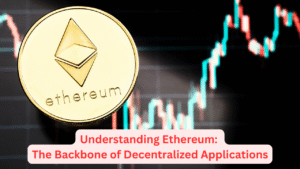 Understanding Ethereum: The Backbone of Decentralized Applications
Understanding Ethereum: The Backbone of Decentralized Applications
Cryptocurrency has transformed the financial landscape in less than two decades. While Bitcoin is often the first name people associate with this revolution, Ethereum is arguably just as significant—if not more so—in terms of real-world utility. It is not merely a digital currency; it’s a powerful platform that enables developers to build decentralized applications (dApps), smart contracts, and a host of other innovations that could redefine everything from finance to healthcare to governance.
What is Ethereum?
Ethereum is an open-source, blockchain-based platform that allows developers to build and deploy decentralized applications. Launched in July 2015 by Vitalik Buterin and a group of co-founders, Ethereum was designed to overcome Bitcoin’s limitations. While Bitcoin was built primarily as a digital currency, Ethereum was built as a **decentralized computing platform**.
At the core of Ethereum is Ether (ETH), the native cryptocurrency used to compensate participants for computations performed and to pay transaction fees on the network. Ether is often referred to as “digital oil,” powering the Ethereum ecosystem.
The Ethereum Blockchain: More Than Just Currency
It’s true innovation lies in its programmable blockchain, which supports the use of smart contracts. These are self-executing contracts with the terms of the agreement directly written into lines of code. Once deployed, smart contracts run exactly as programmed, without any possibility of fraud or third-party interference.
Imagine a vending machine: you insert money, select a product, and the machine automatically delivers it. No human is required to verify the transaction. Smart contracts work the same way, but they can execute far more complex instructions—such as transferring ownership of digital assets, managing voting systems, or automating insurance claims.
Key Features
1. Smart Contracts
The smart contract functionality allows anyone to write and deploy their own code on the blockchain. This unlocks an enormous range of applications—from games and social media to banking and real estate.
2. Decentralized Applications (dApps)
Ethereum allows developers to build decentralized apps that are not controlled by a single entity. dApps operate on a peer-to-peer network, making them more secure and censorship-resistant than traditional apps.
3. Ethereum Virtual Machine (EVM)
The EVM is the runtime environment for smart contracts in Ethereum. It allows code to be executed exactly as intended, making it a powerful tool for developers to create decentralized logic and functions.
4. Ethereum 2.0 (The Merge)
In September 2022, Ethereum transitioned from a Proof-of-Work (PoW) consensus mechanism to Proof-of-Stake (PoS) in an event called The Merge. This shift drastically reduced Ethereum’s energy consumption by over 99%, addressing one of the biggest criticisms of blockchain technology—its environmental impact.
Ethereum vs. Bitcoin
While both Ethereum and Bitcoin are cryptocurrencies, they serve very different purposes:
| Feature | Bitcoin | Ethereum |
| Launched | 2009 | 2015 |
| Purpose | Digital money | Smart contracts & dApps |
| Programming Capability | Limited | Fully programmable |
| Consensus Mechanism | PoW | PoS (since 2022) |
| Max Supply | 21 million | No fixed limit |
Bitcoin is often viewed as “digital gold,” ideal for storing value. Ethereum, on the other hand, is seen as a decentralized world computer, powering a broad ecosystem of applications.
Real-World Applications
The system has already begun transforming multiple industries through its decentralized capabilities. Some notable areas include:
1. Finance (DeFi)
Decentralized Finance (DeFi) refers to financial services built on the Ethereum blockchain, including lending, borrowing, trading, and earning interest—without intermediaries. Platforms like Uniswap, Aave, and Compound allow users to access financial services directly from their crypto wallets.
2. Non-Fungible Tokens (NFTs)
Ethereum is the leading blockchain for NFTs, which are unique digital assets that represent ownership of art, music, videos, and other digital or physical items. NFTs use Ethereum’s smart contracts to guarantee authenticity and ownership.
3. Gaming
Blockchain-based games like Axie Infinity and Decentraland use Ethereum to allow players to own in-game assets, trade them, and even earn real-world value.
4. Supply Chain Management
Ethereum can track the origin and movement of goods across a supply chain, improving transparency, traceability, and trust.
5. Identity and Governance
Smart contracts can help manage digital identities and voting systems, making processes more secure and less prone to manipulation.
Risks and Challenges
While Ethereum offers groundbreaking potential, it also faces some challenges:
Scalability: As usage grows, there are issues with network congestion and high gas fees (transaction costs). Layer 2 solutions like Arbitrum, Optimism, and Polygon aim to solve this.
Security: Smart contracts are only as good as the code written. Poorly written contracts have led to significant hacks and losses.
Regulation: As Ethereum-based applications handle more value, they are drawing the attention of governments and regulators worldwide.
Competition: Ethereum faces strong competition from newer blockchains like Solana, Cardano, and Avalanche, which promise faster and cheaper transactions.
The Future
Ethereum continues to evolve. Its roadmap includes key upgrades such as:
Sharding: This is a method of splitting the network into smaller pieces (“shards”) to improve scalability and reduce costs.
Improved UX: Future improvements aim to make it more user-friendly for non-technical users, expanding its accessibility.
Mass Adoption: As institutions and governments explore blockchain applications, it is often their first choice due to its developer community and established infrastructure.
Conclusion
Ethereum is much more than a cryptocurrency—it’s a transformative technology that is reshaping how we think about finance, ownership, trust, and governance. Whether you’re an investor, a developer, or simply a curious observer, understanding it is essential to grasping the broader potential of blockchain technology.
As the backbone of decentralized applications, Ethereum is not just participating in the future of the internet—it’s helping to build it.